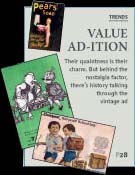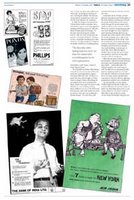Acoustic branding at its best. Wherever we hear that distinctive "Ting ting ti-ting," we invariably think Britannia. Louis Banks, the man who created it, says, "Well, I always say that on my tombstone they should put that four note signature I wrote for Britannia - you know, 'ting ting ti-ting'!"
If you need a ting ting ti-ting of your own, follow the following links to download or listen (you might also use it as a ringtone). It would help if you buy a packet of Tiger Biscuits too. For two reasons, indirect royalty payment and in celebration of Dada's return to the team (the Bong in me just couldn't help it).
* MP3 version [MP3 17.5 KB 00:00:01 128kbps Mono 44 kHz]
* MIDI version [MIDI 268 bytes 00:00:01]
Britannia ads have never been something to go gaga about. Anyway if you happen to be interested, a dozen-and-two TVCs can be found here. And Jazz-man Louis' site has three full-version songs available for free download. Help yourselves.
Click here for the complete post...
Collapse this post
 "I'm going to tell you a secret: Glamour photography is hypocrisy. It's a subtle, sophisticated, suave, creative, legal, socially, and publicly approved version of porn. It's for the debonair and the creative solutions to make stimulation legal have generated an array of interesting styles."
"I'm going to tell you a secret: Glamour photography is hypocrisy. It's a subtle, sophisticated, suave, creative, legal, socially, and publicly approved version of porn. It's for the debonair and the creative solutions to make stimulation legal have generated an array of interesting styles."
We all know it. Just that we didn't like to accept it publicly. Tarun Khiwal does it for us in the December issue of Better Photography.
My brother, an avid photographer, brought home those photography magazines. Not much into the nuances of the hobby/profession (the interest developed much later), I simply used to flip through the pages eyeing the luscious models. My favourite was (is) the glamour specials. The December issue of Better Photography usually has an extra dose of glamour (read scantily clad or unclad women. It's always women). Therefore I never find them at the old and second-hand magazine sellers. This year's is less explicit, but for a wannabe photographer like me, the other stuff in there is more than the Rs 60 worth.
Click here for the complete post...
Collapse this post
 The name National Capital Region (different from NCT) seems to exist only on paper and for the mobile phone networks. Spanning three states, it is just an excuse for incessant traffic jams and inflated property prices. For a poor non-vehicle-owning commuter like me, travelling across the NCR is a pain in the you-know-where. Delhi Transport Corporation buses do not enter Uttar Pradesh and UP no longer plies its vehicles into Delhi. Both sides impounded a number of the other's buses. Things are also not very good down south with Haryana. Delhi registered autorickshaws do not cross the interstate border into Gurgaon and the ones which agree to enter Uttar Pradesh demand a ransom. The overcrowded privately run blue-line buses and the infrequent chartered buses provide little respite.
The name National Capital Region (different from NCT) seems to exist only on paper and for the mobile phone networks. Spanning three states, it is just an excuse for incessant traffic jams and inflated property prices. For a poor non-vehicle-owning commuter like me, travelling across the NCR is a pain in the you-know-where. Delhi Transport Corporation buses do not enter Uttar Pradesh and UP no longer plies its vehicles into Delhi. Both sides impounded a number of the other's buses. Things are also not very good down south with Haryana. Delhi registered autorickshaws do not cross the interstate border into Gurgaon and the ones which agree to enter Uttar Pradesh demand a ransom. The overcrowded privately run blue-line buses and the infrequent chartered buses provide little respite.
In this urban chaos, there comes to the rescue an unlikely saviour - the call centre cabs. Infamous for their negligent and rash driving, these cabs are a boon to travellers commuting between Noida, Delhi and Gurgaon. The main motive might be money making in the sly by the drivers, but it also doubles up as 'social service,' providing cheap, fast and comfortable travel in a city which only has the metro rail to boast about in the name of efficient public transport (the high-capacity buses are too few and DTC drivers get their cut from their blue-line competitors for not picking up passengers). Rs 10 for any distance traveled and I like to add a little thank you for the driver, whose 'selfish motive' eases an otherwise arduous journey.
Depending on the size of the vehicle they drive, the drivers make anything between Rs 40-100 a trip. Often the cops demand a tenth-of-a-grand. The driver simply smiles, displaying his tobacco stained teeth, "Soochonga free mein lift de diya (I'll think that I've given a lift for free)."
Well, it was almost free for me. Rs 10 for a smooth ride from Noida to Dhaula Kuan and another tenner for Dhaula Kuan to Gurgaon (a distance of over 40 kilometres) and that too in only an hour's time.
Click here for the complete post...
Collapse this post
 [My daytime job requires me to write. But I refrain from reproducing it here, on the blog. Primarily because they are two different entities. The me on the blog is quite different from the me in the publications I work for. But the following is different. One, I don't work for this publication. Two, I didn't write this for the greens. Three, this is because of what I do on this blog and it was just an extension on printed paper.
[My daytime job requires me to write. But I refrain from reproducing it here, on the blog. Primarily because they are two different entities. The me on the blog is quite different from the me in the publications I work for. But the following is different. One, I don't work for this publication. Two, I didn't write this for the greens. Three, this is because of what I do on this blog and it was just an extension on printed paper.
I would also like to thank two people. Shivam who asked me to do this and Shyama Haldar, who I believe did the subbing on the piece (adding a great deal of readability to the original info-clogged crap).
Sub-editing is a thankless job. You have to dirty your hands clearing all the rubbish and rearranging the stuff. Often ending up rewriting the entire thing, only to see the byline reading someone else's name.
A little misspelt surname can always be ignored]
Excerpted from Tehelka (Vol. 3 Issue 48. For the week of December 3-9, 2006).
 "If the product is good, what do they need to advertise it for?” is the dour sort of question most of us grew up hearing from our elders at home. Regardless of the offence it gave the older generation’s socialist sensibilities, and despite the nationalisation of private entities, advertising in India continued nonetheless to thrive, just as it had done ever since the Irishman James Augustus Hickey published Hickey’s Bengal Gazette, two-and-a-quarter centuries ago. As a six-year-old pouring over Indrajal comics, there’s no way I could have known, or cared, what ads were doing to help keep the price of Phantom, Bahadur and Mandrake in reach. Today, of course, I know better. Advertising gives me free-to-air channels, helps me run a personal space on the Internet for free, provides me with instant e-communication at no explicit cost and gets me newspapers at a price so low I can get a substantial part of it repaid by the raddiwallah.
"If the product is good, what do they need to advertise it for?” is the dour sort of question most of us grew up hearing from our elders at home. Regardless of the offence it gave the older generation’s socialist sensibilities, and despite the nationalisation of private entities, advertising in India continued nonetheless to thrive, just as it had done ever since the Irishman James Augustus Hickey published Hickey’s Bengal Gazette, two-and-a-quarter centuries ago. As a six-year-old pouring over Indrajal comics, there’s no way I could have known, or cared, what ads were doing to help keep the price of Phantom, Bahadur and Mandrake in reach. Today, of course, I know better. Advertising gives me free-to-air channels, helps me run a personal space on the Internet for free, provides me with instant e-communication at no explicit cost and gets me newspapers at a price so low I can get a substantial part of it repaid by the raddiwallah.
 Unabashedly, I am one of those people who hordes old magazines and newspaper clippings; under my bed hibernate cartons of half-century-old printed pulp, fraying edges providing tell-tale evidence of well-fed silverfish. Flipping through them, it’s the ads that still arrest: quaint, even rudimentary by today’s glossy standards, yet their appeal not just intact but enhanced by nostalgia’s natural preservatives. Ads, after all, tell stories history tellers might not have thought worth picking up on. In the early years of Indian advertising, till the 1930s, foreign manufacturers used the same advertising here as they did in their home countries. The first Lux-loving Indian film star was featured in 1941 (Leela Chitnis). The Hinglish that purists so despise had made its incursions into advertising lingo by the last quarter of the 19th century. Colour ads entered The Times of India in 1910. Kodak’s revolutionary, “You press the button. We do the rest” inspired this chilling spin-off from G. Edward’s & Co, a Calcutta-based taxidermist: “You shoot!! We do the rest,” to the near-extinction of the national animal.
Unabashedly, I am one of those people who hordes old magazines and newspaper clippings; under my bed hibernate cartons of half-century-old printed pulp, fraying edges providing tell-tale evidence of well-fed silverfish. Flipping through them, it’s the ads that still arrest: quaint, even rudimentary by today’s glossy standards, yet their appeal not just intact but enhanced by nostalgia’s natural preservatives. Ads, after all, tell stories history tellers might not have thought worth picking up on. In the early years of Indian advertising, till the 1930s, foreign manufacturers used the same advertising here as they did in their home countries. The first Lux-loving Indian film star was featured in 1941 (Leela Chitnis). The Hinglish that purists so despise had made its incursions into advertising lingo by the last quarter of the 19th century. Colour ads entered The Times of India in 1910. Kodak’s revolutionary, “You press the button. We do the rest” inspired this chilling spin-off from G. Edward’s & Co, a Calcutta-based taxidermist: “You shoot!! We do the rest,” to the near-extinction of the national animal.
The complete text can be accessed here.
Click on the links below for a complete newspaper view (complete with select vintage ads).
Page 1: JPEG | PDF
Page 2: JPEG | PDF
Click here for the complete post...
Collapse this post















































